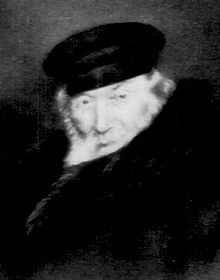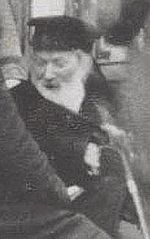- Yisrael Meir Kagan
-
Yisrael Meir Kagan 
Age 91, on his visit to the Polish Prime MinisterBorn February 6, 1838 (11 Shevat 5598)
DzyatlavaDied September 15, 1933 (aged 95) (24 Elul 5693)
Radun'Yisrael Meir (Kagan) Poupko (Dziatłava, 1838 - Radun', 1933), known popularly as The Chofetz Chaim, was an influential Eastern European rabbi, Halakhist, posek, and ethicist whose works continue to be widely influential in Jewish life. His surname, Poupko, is not widely known.[1]
Contents
Biography
Rabbi Kagan was born in Zhetl, Hrodno Guberniya, today's Belarus, on February 6, 1838, and died in Radun', Wilno Voivodship, Poland (pop. 250), today's Belarus, on September 15, 1933. When Kagan was ten years old, his father died. His mother moved the family to Vilnius in order to continue her son's education. While in Vilnius, Kagan became a student of Rabbi Jacob Barit. Kagan's mother later re-married (Poupko) and moved to Raduń. At 17, he married the daughter of his stepfather, and settled in Raduń.
He served as the town rabbi of Raduń for a short period. He then resigned from this position to establish the yeshiva in Raduń, which eventually became world famous. By all accounts he was a modest and humble man. For a while he had a shop selling household provisions, which his wife managed.[2] However, the business was not successful and he turned to teaching in order to support himself and his family. From 1864 to 1869 he taught Talmud in Minsk and Washilishok.[3]
In 1869, he formed a Yeshiva in Radun. The Yeshiva was a success and grew to prominence, later becoming known as "Yeshivas Chofetz Chaim of Raduń." In addition to spreading Torah through his yeshiva, the Chofetz Chaim was very active in Jewish causes. He traveled extensively to encourage the keeping of the Mitzvot amongst Jews. He became one of the most influential rabbis within Orthodox Judaism during the late 19th and early 20th century, taking a central leadership role in the World Agudath Israel movement in Eastern Europe.
Many other Jewish religious institutions throughout the world also bear his name. One American yeshiva named in his honor is the Yeshivas Rabbeinu Yisrael Meir HaKohen centered in Queens, New York, with several branches in the United States and Israel. The Chofetz Chaim's teachings have inspired some English-speaking American Jews to establish the Chofetz Chaim Heritage Foundation, dedicated to the dissemination of his teachings to Jewish communities around the world. An Orthodox kibbutz in Israel was named in his honor.
Works
- Chafetz Chayim (חָפֵץ חַיִּים "Seeker/Desirer [of] Life"), his first book, (published in 1873), deals with the Biblical laws of gossip and slander (known in Hebrew as Lashon Hara, meaning "Evil tongue"). View the online edition in Hebrew here
- Sh'mirat HaLashon ("Guarding [of] the Tongue"), is a comprehensive discussion of the philosophy behind the Jewish concepts of power of speech and guarding one's speech. It also serves as an inspirational work designed to motivate the reader to be vigilant in the ethical usage of his speech and avoidance of others' unethical speech. Published in 1876. View the online edition in Hebrew here
- Mishna Berura ("Clarified teachings") is an important and widely-used commentary, consisting of six volumes, on the Orach Chayim section of Yosef Karo's digested compilation of practical Jewish Law, the Shulchan Aruch. It combines his own elucidations and differing opinions with those of other Aharonim (post-medieval authorities.) [As found in the book by Rabbi Moses M. Yoshor "The Chafetz Chaim" on page 603 the 1st volume was published in 1884; 2nd volume in 1886; 3rd volume in 1891; 4th volume in 1898; 5th volume in 1902; 6th volume in 1907.]
- Beiur Halacha ("Explanation of the Law") is a commentary tangential to the Mishna Berurah. It usually provides complex analysis of the legal rulings of earlier Jewish legal decisors.
- Sha'ar HaTziyyun ("Gate of Distinction") serves primarily to document sources for laws and customs quoted in the Mishnah Berurah, but sometimes serves also to clarify ambiguous legal statements. The name Sha'ar HaTziyyun derives from the phrase sh'arim m'tzuyanim ba'halacha, translated as "gateways distinguished in (or marked in) Jewish Law," referring to the Torah study and scholarship that would distinguish Jewish homes. Rabbi Kagan chose the title as a pun, hinting at the distinction of the scholarship referenced in his work, but primarily referring to (as he writes on his title page) the function of Sha'ar HaTziyyun to document (mark) sources.
- Ahavas Chesed - One volume. On the commandment of lending money to the needy.
- Machaneh Yisrael - One volume. On the minimum and manner of observing the Jewish commandments for a soldier in the army.
- Tiferes Adam - One volume. On the importance of a Jew having a beard and peyos (sidelocks).
- Geder Olam - One volume, published in 1890. On the importance of a married Jewish woman covering her hair.
- Nidchei Yisrael - Two volumes, published in 1893.
- Shem Olam - One volume, published in 1893.
- Chomas Hadas - 1 Volume, published in 1905. On the importance of a man to study Torah, and encourage others to learn. as well as the need to create groups in every city wherein a man could acquire Torah.
- Likutei Halachos - 5 Volumes. The first volume was published in 1900; 2nd volume in 1903; 3rd volume in 1913; 4th volume in 1922. There is a fifth volume called "Hashlamah" or "Completion" which was published in 1925.
- Gibores Ari - 2 volumes, published in 1907.
- Taharas Yisrael - 1 volume, published in 1910.On the importance of women to purify themselves in the waters of a mikvah (ritual bath) in accordance with accepted halachic practice.
- Toras Kohanim - 1 volume, published in 1911.
- Asifas Zikainim - 3 volumes, published in 1913.
- Chovas Hashmirah - 1 volume, published in 1915.
- Toras Habayis - 1 volume, published in 1923.
- Zechor Limiriam - 1 volume, published in 1925.
- Beis Yisrael - 1 volume, published in 1925.
- Sefer Hamitzvos Hakotzer - 2 volumes on those biblical commandments that are applicable during the exile, outside the land of Israel, and when the temple is not in existence. Published in 1931.
- Tzipita L'Yeshuah ("Have you yearned the redemption") is based on a passage from Tractate Shabbat, which states that after one passes away, he is asked by the heavenly court: "Have you yearned for the redemption?" This work describes the importance of actively awaiting Moshiach every day and doing everything in our power (learning Torah and doing mitzvot) to bring the redemption. The Chofetz Chaim's expectation of the immediate redemption was so strong that he would always carry special garments to change into once the redemption begins.
References
- ^ "Israel Meir Ha-Kohen" Encyclopedia Judaica. Jerusalem: Keter, 1972.
- ^ Chofetz Chaim
- ^ Moses M. Yoshor, Israel Meir haKohen in Jewish Leaders, ed. Leo Jung. P. 462.
Bibliography
- Yoshor, Moses Meir (June 1986) [1937]. Chafetz Chaim, the life and works of Rabbi Yisrael Meir Kagan of Radin. rendered into English by Charles Wengrov (1st Revised ed.). New York, NY: Mesorah publications. ISBN 0-89906-462-0.
- "The New York Times". 16 September 1933.
External links
Categories:- 1838 births
- 1933 deaths
- People from Dzyatlava
- Belarusian Orthodox rabbis
- Haredi rabbis in Europe
- Rosh yeshivas
- Polish Orthodox rabbis
- Kohanim
- Kohanim authors of Rabbinic literature
Wikimedia Foundation. 2010.

